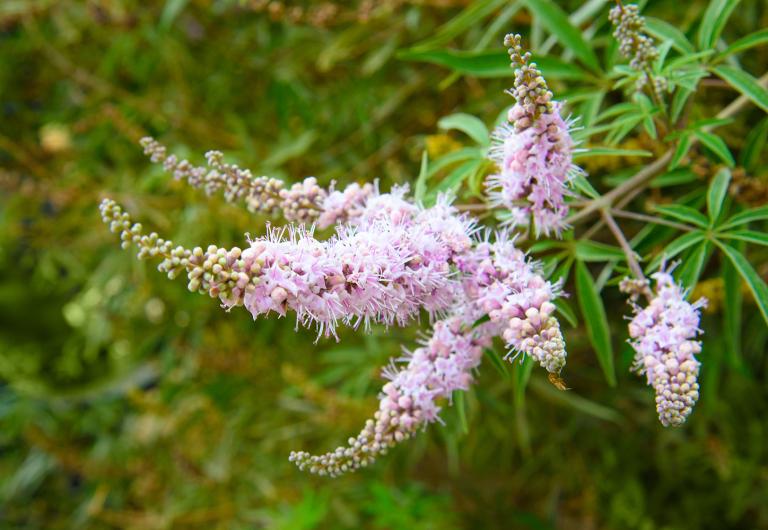The herb Vitex is the MVP when it comes to menstrual regularity.
The berries of Vitex agnus-castus, or chaste tree, have been used since antiquity.
In modern times, chasteberry (also called monk’s pepper, chaste tree fruit, chaste tree berry, or, simply, vitex) has become one of the most relied-upon botanicals in Western herbal medicine for the treatment of a wide array of gynecological complaints, from infertility to menopause.
Tame PMS with Vitex
One of the primary uses of chasteberry is for the treatment of premenstrual syndrome (PMS).
Clinical studies have reported on vitex’s ability to alleviate or reduce irritability, mood alteration, anger, headache, breast fullness, restlessness, and fluid retention (edema).
In these studies, while effectiveness was assessed after three cycles, many users noticed improvements within the first cycle.
Other studies have reported the effectiveness of chasteberry in reducing anxiety, sugar cravings, depression and crying spells, lack of concentration, and breast pain.
Treat Cyclical Conditions Effectively with Vitex
-
Reduce Breast Pain
Chasteberry is effective for the treatment of breast pain, or mastalgia. Vitex has been found to be nearly as effective as the hormone progesterone in combating premenstrual mastalgia.
Its effects are thought to be partly the result of chasteberry’s action as an inhibitor of prolactin, the primary hormone associated with milk production in new mothers. Elevated prolactin levels may contribute to breast pain.
Pain and swelling in the breasts, however, should be assessed by a healthcare provider to rule out other conditions
-
Menstrual Cycle Regulation
One of the most specific uses of chasteberry is for the treatment of several menstrual irregularities: lack of menses, abnormally long menstrual cycles, abnormally frequent menses (cycles shorter than 26 days), and infertility.
Chasteberry is the herb of choice for its ability to regulate the cyclical hormonal fluctuations that occur throughout the month, specifically a normalization of the luteal phase of the menstrual cycle and progesterone levels.
-
Menopause Relief
In Germany, clinicians recommend chasteberry for the management of menopausal symptoms, including hot flashes, sweating, insomnia, and depression.
-
Vitex for Acne Management
Acne is often a result of hormonal imbalance. In one study, a group of patients treated with chasteberry was reported to show a quicker healing time after six weeks. Lapses in treatment resulted in a relatively frequent recurrence of symptoms after three to six weeks.
After three months, 70 percent of the patients who had failed to respond to prolonged conventional therapy prior to the study showed complete healing.
-
Other Uses for Vitex
American herbalists offer chasteberry for the treatment of uterine fibroids and cysts as well as endometriosis.
Although conventional medicine’s response to these common conditions is often to recommend partial or complete hysterectomies, many such surgeries are considered unnecessary when patients seek a second opinion.
Vitex Quality & Safety
Good quality chasteberries have a strong, warming taste somewhat akin to black pepper.
However, a number of vitex species used in Ayurvedic and Chinese medicine do not possess this characteristic and, therefore, may not be effective for the purposes mentioned here.
For ensuring quality, taste is really the best test. Even a small taste from your tablet, tincture, or capsule will tell you if the herbal product possesses the characteristic pungency.
Side Effects of Vitex
The mild side effects reported for chasteberry (upset stomach, acne, occasional headache, and itching) are uncommon.
Can Vitex Be Used During Pregnancy?
The Botanical Safety Handbook, a textbook reviewing the safety of botanicals, advises that chasteberry not be used in pregnancy, based on reports in the historical literature of its use for bringing on the menstrual cycle.
While there is no substantiation in the modern clinical literature regarding this effect, it is nevertheless a caution to consider following.
Similarly, the Handbook states that chasteberry may interfere with the effectiveness of oral contraceptives. However, there is also no substantiation for this in either modern studies or the experience of clinicians.
Support Woman's Health Naturally with Vitex
Given the broad range of conditions for which it is used, it is no wonder that vitex has become indispensable to US herbalists and naturopathic physicians.
Its importance is further accentuated by the fact that allopathic medicine has little to offer to women for gynecological care.
Surgery and powerful hormonal therapies—with their own sets of risks and side effects continue to be the treatments of choice for American women unfamiliar with the benefits of chasteberry.

